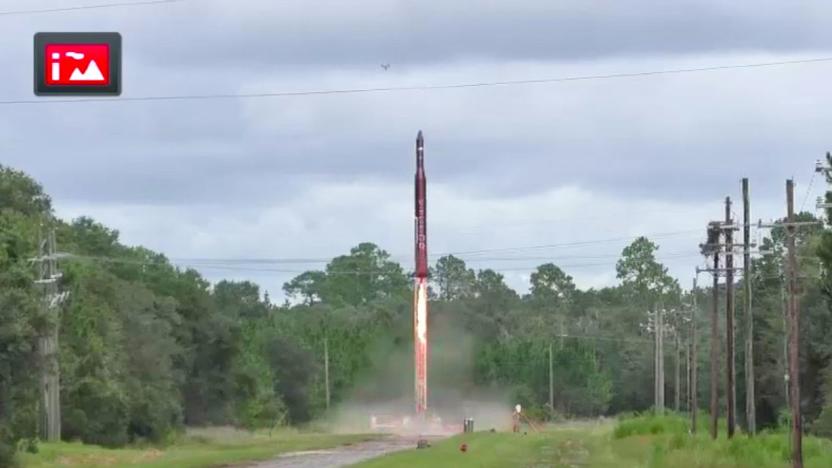nanosatellite
Latest

Vector successfully launches prototype rocket for small satellites
Today, Vector, a company that aims to deliver small and nano-satellites into orbit, successfully launched a full-scale prototype of its Vector-R rocket. It was a suborbital flight; the rocket took off from a spaceport in Camden, GA. It's the first for Vector (and for the small-satellite launching industry) that is fully funded by customers and has their payloads on board.

NASA wants more ideas for its low-cost CubeSat nanosatellites
NASA's CubeSat is a (sort-of) adorable tiny satellite that makes space exploration a (relatively) low-cost prospect. Now, the space agency is looking to offer the cube's talents and exploration skills to even more NASA centers, educational institutions and non-profit organizations. Developers will get be able to conduct research that's "consistent with NASA's strategic plan". CubeSats will be launched by February of 2016, but being selected doesn't necessarily mean that project will launch.

US Army wants to send small, cheap satellites to space
The military has been conjuring up one idea after another in an effort to improve its personnel's ability to communicate, such as putting LTE on a ship and launching a WiFi router to space. This time, the US Army is in the midst of testing nanosatellites that will provide coverage for soldiers' radios wherever they are. The Army's having trouble providing a means of communication between soldiers in rural areas, and these small satellites called SMDC-ONE (ONE stands for Orbital Nanosatellite Effect) can solve that issue. "It's basically a cellphone tower in space," Dr. Travis Taylor, a senior scientist of the Army's space division said, "except it's not for cellphones, it's for Army radios." His team made sure SMDC-ONEs are tough enough to survive harsh conditions, but since the devices are small, they could still be displaced by space junk or ruined by adverse space weather.

NASA PhoneSat returns photos from orbit, reminds us of streaming circa 1998
The launch of NASA's PhoneSat mission last year was loaded with promise: finally, proof that mobile technology could power nanosatellites and stick it to The Man. The photos have returned, and... well, Lockheed won't be scrapping its big satellites just yet. While we're impressed that the Nexus Ones onboard the three PhoneSats delivered images from orbit through amateur radio waves, the transmission artifacts are more like those from 15-year-old online videos than what we see on the ground today. Don't think that the effort was in vain, however -- far from it. While the inaugural PhoneSats have burned up in reentry, as expected, future iterations should build on the experience and make a better case for small-scale spacecraft.

DIYRockets starts a challenge to build open source, 3D-printed rocket engines
DIYRockets believes that our chances of advancing space exploration improve when everyone can lend a hand. The company is putting its money where its mouth is by launching a competition to develop 3D-printed rocket motors using Sunglass' cloud design platform. Teams who sign up have to build an engine that could boost a nanosatellite-level payload into low Earth orbit using 3D-printed steel and other safe materials. The only major stipulations are that creators present a good business case and open-source their creations to help out other builders. DIYRockets' prize strategy reflects its for-the-greater-good ambitions: there's a $5,000 award for the best motor, but there are separate $2,500 prizes for both a student creation and the design that contributes the most to the industry. Registration officially starts on March 9th, and runs until April 6th, with the finished models due on June 1st. We'll be closer to a crowdsourced vision of space when the winners are revealed by July 1st.

ExoPlanetSat nanosatellite to begin search for alien worlds next year
SETI's search for intelligent life in outer space may be on ice for the time being, but the search for alien planets that may possibly support life of some sort is now being bolstered by a number of new efforts. One of the latest is the so-called ExoPlanetSat nanosatellite developed by MIT and Draper Laboratory, which recently got the go-ahead from NASA's Cubesat Launch Initiative and is now set to hitch a ride into space sometime in 2012. While not quite as "nano" as the SIM card-sized satellites that launched with the Shuttle Endeavor, the smaller-than-a-breadbox ExoPlanetSat is still pretty tiny by satellite standards, yet it packs all the necessary optics and technology required for what's known as transit observation -- that is, monitoring a star for decreases in brightness, which could indicate a planet passing in front of it. What's more, while the launch of a single satellite is plenty to get excited about, the researchers hope that it lead the way for a whole fleet of similar nanosatellites that could greatly speed up the search for planets.

NASA successfully launches NanoSail-D solar sail from microsatellite in space
Took 'em long enough, don'tcha think? After talking things up for years (and getting dangerously close to pulling the trigger in mid-2008) NASA has finally ejected a solar sail into space. But that's not the kicker -- it managed to eject NanoSail-D from a microsatellite, dubbed FASTSAT. We're told that this "is the first time NASA has mounted a P-POD on a microsatellite to eject a cubesat," and sure enough, things have gone swimmingly ever since the mission began on Friday. Aside from giving NASA the ability to test out the effectiveness of using a solar sail in orbit, this also proves that FASTSAT is a "cost-effective independent means of placing cubesat payloads into orbit safely" -- that's according to Mark Boudreaux, FASTSAT project manager at the Marshall Space Flight Center in Huntsville, Alabama. Moreover, the NanoSail flight results could lead to new methods of de-orbiting space debris in the future, not to mention get more and more of 'em there to begin with at a lower overall cost and with far less hassle.





